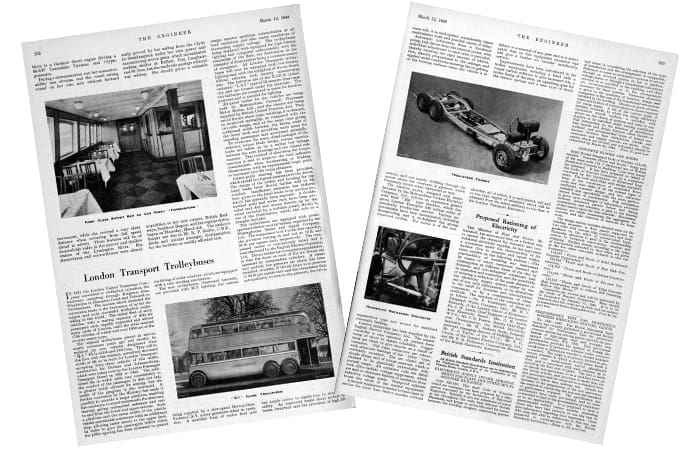An electrically-driven fleet of trolleybuses, with motors built by the Metropolitan-Vickers Electrical Company, provided Londoners with emission-free transport around the capital for nearly 30 years. Jason Ford reports
London has a well-documented problem with its air, the quality of which is estimated to cause 9,400 premature deaths a year. Consequently, efforts are being made across the capital to introduce an ultra-low emissions zone that will impose charges on road vehicles that fail to meet clean air criteria.
Efforts toward this laudable goal include the introduction this year of 240 electric double-decker buses on to the network, where they will join more than 2,600 diesel-electric hybrid buses helping to deliver over two billion passenger journeys a year. A further 4,100 Euro VI compliant buses are helping to improve air quality in a city that is phasing out diesel-engine buses.
Electric-drive is currently playing its part in solving a problem brought about by noxious vehicle emissions, but in 1948 London’s transport chiefs were already part-renewing a fleet of zero-emission vehicles that were popular with passengers, very reliable and hadn’t required major changes to infrastructure to roll them out.

London’s trolleybuses first appeared in May 1931 and by September of that year London United Tramways (LUT) had 60 vehicles each carrying up to 56 passengers operating on five routes – formerly served by trams – in south west London.
By 1933 LUT was taken over by London Passenger Transport Board (LPTB) which took the same approach to using tramways to grow the trolleybus network and fleet. According to Transport for London’s Corporate Archives Research Guides, the tram network suffered from obsolescence, was expensive to run, and seen by the public as being old fashioned and a cause of congestion. The motor bus as we know it was in its infancy and wasn’t yet viable in terms of passenger capacity or operating cost. The tram network did, however, leave a legacy in the form of working power stations, substations and high-tension overhead cables that would help give trolleybuses the infrastructure to expand to 1,764 vehicles – 1,600 of which were 70-seat double-deckers.
The Engineer described this expansion as “by far the largest and most successful trolleybus undertaking in the world”, little knowing that London’s trolleybuses would operate until 1960 and, with the exception of two units, be sold to transport operators in Spain.
The new Q/1 trolleybus was 30ft long and 8ft wide, an extra six inches that added “very considerably to the comfort of the passenger” and widened the vehicle’s gangway.
“A further concession… has made it possible to provide a larger platform, enabling the conductor to stand underneath the staircase, thereby giving unimpeded entrance and exit to and from the lower and upper saloons,” said The Engineer’s correspondent. “Such a platform and the extra width of the vehicle render practicable a staircase with an additional step, allowing easier ascent to the upper deck.”
The vehicle’s two batteries – described as NIFE nickel cadmium LS5s with a 52-ampere-hour capacity – could also be found beneath the staircase and were connected in series for traction and in parallel for lighting. The Q/1’s all-metal bodies were built by Metropolitan Cammell Weymann Motor Bodies, Ltd, and chassis were provided by British United Traction Ltd.
“They are of the six-wheel type, resulting, it is claimed, in improved springing, as compared with the two-axle design, and at the same time giving additional width between the facing seats of the lower deck and providing more space for standing passengers and movement generally,” The Engineer said.
Westinghouse Brake and Signal Company Ltd supplied the Q/1’s pedal operated electric and air brakes, with our correspondent noting “the air brakes have complete equalisation, in that the shoes on each of the six drums are operated by independent cylinders. A visual and audible low-pressure air alarm has been installed, whereby, if the air drops to a pressure of 50lb per square inch and the compressor fails automatically to restore the pressure, the driver has ample notice to enable him to stop with safety. An improved brake drum section to lessen distortion and the provision of high-lift cams will, it is anticipated, considerably lessen maintenance work and possible delays.”
The Q/1 was preceded by a fleet of type 201 trolleybuses. Nicknamed Diddlers by those who travelled on them, the 201 gave London Transport “500 million miles of practically trouble-free service”. Lessons learned from its operation were carried forward into the Q/1’s design, including the vehicle’s traction motor, which was designed and built by the Metropolitan-Vickers Electrical Company. Further improvements were incorporated, including flood-proofing and a redesigned fan giving improved cooling.




Swiss geoengineering start-up targets methane removal
No mention whatsoever about the effect of increased methane levels/iron chloride in the ocean on the pH and chemical properties of the ocean - are we...